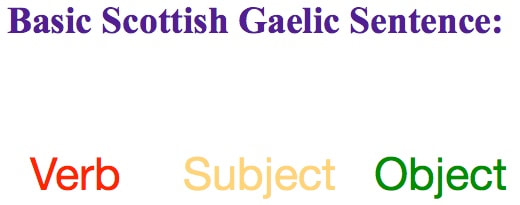|
Gaelic sentences can seem very confusing when an English speaker first starts looking at them. A lot of that is because Gaelic sentences have a very different order than English sentences. So lets take a look
At the most basic level Gaelic is a VSO language which means sentences go like this: Verb Subject object. Looking at this shows us one of the main differences, the verb comes first.
The first type of Gaelic sentence that you are likely to encounter is the present tense sentence. The most common of these look like this: Tha mi ag obair. literally It is me at working and the order is:verb pronoun present participle. The great thing about Gaelic is that you can build sentences fairly easily if you know what your options are for each part. So in the example above the first part is the verb. You would think that you would have millions of choices here but in the present tense most sentences start off with the verb 'to be', so your choice is really what sort of sentence you want to make. Gaelic verbs don't conjugate like other European verbs depending on who you are talking about but they do change depending on what type of sentence you are making. So the choices you have here are: Positive statement, negative statement, positive question and negative question. They look like this: Tha positive statement something is Chan eil. negative statement. something is not A bheil. Positive question. Is something? Nach eil. negative question. isn't something? Because these aren't going to change or be changed by the other parts of the sentence you can just swap them around and make different sentences. Ie Tha mi ag obair ----> Chan eil mi ag obair. The next slot is the subject slot which usually contains a noun or a pronoun. If you are going to use a noun like a name or a thing you have almost endless choices here but if you choose a pronoun (I, you, he she etc) you have a very manageable 7 choices here. mi = I thu = you (singular and informal) e = he i= she sinn= we sibh =you (formal or plural ) iad = they The last slot is for the present participle. In Gaelic this consist of a shortened form of the preposition aig (at), which looks like a' in front of consonants and ag in front of vowels, and the verbal noun form of a verb. This slot does offer a lot of choice but don't be put off. Choose a few verbs to learn at one time and you can have great fun. Here are five useful verbal nouns: ag obair = working ag ithe = eating a' cluich = playing ag òl = drinking a' leughadh = reading simply choose one from each column to make a simple Gaelic sentence
Keep an eye out for further post about how to make Gaelic sentences in other tenses and keep having fun learning Gaelic
0 Comments
Leave a Reply. |
Details
AuthorsCaroline has been involved with Gaelic for more than 18 years. She has degrees in Celtic Studies and Gaelic Medium Teaching. Archives
March 2021
Categories
All
|
Proudly powered by Weebly




 RSS Feed
RSS Feed